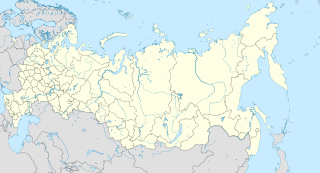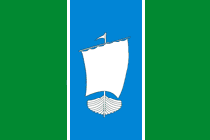Coordinates: 60°04′N38°00′E / 60.067°N 38.000°E

A geographic coordinate system is a coordinate system that enables every location on Earth to be specified by a set of numbers, letters or symbols. The coordinates are often chosen such that one of the numbers represents a vertical position and two or three of the numbers represent a horizontal position; alternatively, a geographic position may be expressed in a combined three-dimensional Cartesian vector. A common choice of coordinates is latitude, longitude and elevation. To specify a location on a plane requires a map projection.
| Sheksna River | |
|---|---|
Goritsky Monastery by the river | |
| Country | Russia |
| Physical characteristics | |
| Main source | Lake Beloye 120 m (390 ft) |
| River mouth | Volga River |
| Length | 139 km (86 mi) [1] |
| Discharge |
|
| Basin features | |
| Basin size | 19,000 km2 (7,300 sq mi) [1] |

The Sheksna (Russian : Шексна́) is a river in Belozersky, Kirillovsky, Sheksninsky, and Cherepovetsky Districts of Vologda Oblast in Russia. It is a left tributary of the Volga River. It is 139 kilometres (86 mi) long, and the area of its basin 19,000 square kilometres (7,300 sq mi). The principal tributaries of the Sheksna are the Sizma (left) and the Kovzha (right).

Russian is an East Slavic language, which is official in the Russian Federation, Belarus, Kazakhstan and Kyrgyzstan, as well as being widely used throughout Eastern Europe, the Baltic states, the Caucasus and Central Asia. It was the de facto language of the Soviet Union until its dissolution on 25 December 1991. Although, nowadays, over two decades after the breakup of the Soviet Union, Russian is used in official capacity or in public life in all the post-Soviet nation-states, as well as in Israel and Mongolia, the rise of state-specific varieties of this language tends to be strongly denied in Russia, in line with the Russian World ideology.

Belozersky District is an administrative and municipal district (raion), one of the twenty-six in Vologda Oblast, Russia. It is located in the northwest of the oblast and borders with Vytegorsky District in the north, Vashkinsky District in the northeast, Kirillovsky District in the southeast, Cherepovetsky and Kaduysky Districts in the south, and with Babayevsky District in the west. The area of the district is 5,400 square kilometers (2,100 sq mi). Its administrative center is the town of Belozersk. Population: 17,271 (2010 Census); 21,648 ; 24,777 (1989 Census). The population of Belozersk accounts for 55.7% of the district's total population.

Kirillovsky District is an administrative and municipal district (raion), one of the twenty-six in Vologda Oblast, Russia. It is located in the north of the oblast and borders with Kargopolsky and Konoshsky Districts of Arkhangelsk Oblast in the north, Vozhegodsky and Ust-Kubinsky Districts in the east, Vologodsky District in the southeast, Sheksninsky District in the south, Cherepovetsky District in the southeast, Belozersky and Vashkinsky Districts in the west, and with Vytegorsky District in the northwest. The area of the district is 5,400 square kilometers (2,100 sq mi). Its administrative center is the town of Kirillov. Population: 15,877 (2010 Census); 18,627 ; 21,702 (1989 Census). The population of Kirillov accounts for 48.7% of the district's total population.
According to the Max Vasmer's Etymological Dictionary, the origin of the name of the river is unclear, but it may originate from a Finnic language meaning "a woodpecker" or more specific "a spotted woodpecker". [2] The urban-type settlement of Sheksna and Sheksninsky District are named after the river.

Max Julius Friedrich Vasmer was a Russian-born German linguist. He studied problems of etymology in Indo-European, Finno-Ugric and Turkic languages and worked on the history of Slavic, Baltic, Iranian, and Finno-Ugric peoples.
Urban-type settlement is an official designation for a semi-urban settlement, used in several Eastern European countries. The term was historically used in Bulgaria, Poland, and the Soviet Union, and remains in use today in 10 of the post-Soviet states.
The source of the Sheksna is in the southeastern end of Lake Beloye. The river flows south and subsequently turns east. It joins the northern part of the Rybinsk Reservoir of the Volga near the city of Cherepovets. Cherepovets, as well as the urban-type settlement of Sheksna, are located on the Sheksna.

Lake Beloye or White Lake, is a lake in the northwestern part of Vologda Oblast in Russia. Administratively, the lake is divided between Belozersky District (south) and Vashkinsky District (north) of Vologda Oblast. The town of Belozersk, is located on its coast. In terms of area, Lake Beloye is the second natural lake of Vologda Oblast, and the third lake also behind the Rybinsk Reservoir. It is one of the ten biggest natural lakes in Europe.

Rybinsk Reservoir, informally called the Rybinsk Sea, is a water reservoir on the Volga River and its tributaries Sheksna and Mologa, formed by Rybinsk Hydroelectric Station dam, located in the Tver, Vologda, and Yaroslavl Oblasts. At the time of its construction, it was the largest man-made body of water on Earth. It is the northernmost point of the Volga. The Volga-Baltic Waterway starts from there. The principal ports are Cherepovets in Vologda Oblast and Vesyegonsk in Tver Oblast.

Cherepovets is a city in Vologda Oblast, Russia, located in the west of the oblast on the banks of the Sheksna River and on the shores of the Rybinsk Reservoir. As of the 2010 Census, its population was 312,310, making it the most populous city in the oblast.
Most of the present course of the river was accommodated as the Sheksna Reservoir, with the dam constructed in Sheksna. Previously, the length of the Sheksna was some 400 kilometers (250 mi), and the mouth of the river was located in the city of Rybinsk, Yaroslavl Oblast. The part of the river between Cherepovets and Rybinsk disappeared when the Rybinsk Reservoir was constructed between 1935 and 1947. Currently, the only natural stretch of the course of the Sheksna is located between the urban-type settlement of Sheksna and the city of Cherepovets.

The Sheknsna Reservoir or the Sheksninskoe Reservoir is a water reservoir on Sheksna River and Lake Beloye, in Belozersky, Vashkinsky, Kirillovsky, and Sheksninsky Districts of Vologda Oblast in Russia. The reservoir is formed by the dam of the Sheksna Hydropower Plant, located in the urban-type settlement of Sheksna.

Yaroslavl Oblast is a federal subject of Russia, which is located in the Central Federal District, surrounded by Tver, Moscow, Ivanovo, Vladimir, Kostroma, and Vologda Oblasts. This geographic location affords the oblast the advantages of proximity to Moscow and St. Petersburg. Additionally, the administrative center of the oblast—the city of Yaroslavl—is an intersection of major highways, railroads, and waterways. Population: 1,272,468.
The river basin of the Sheksna comprises vast areas in the west and in the northwest of Vologda Oblast, including parts of Vytegorsky, Vashkinsky, Kirillovsky, Belozersky, Sheksninsky, and Cherepovetsky Districts, as well as minor areas in Kargopolsky District of Arkhangelsk Oblast. This area includes the towns of Kirillov and Belozersk, as well as the urban-type settlement of Chyobsara and the selo of Lipin Bor, the administrative center of Vashkinsky District.

Vytegorsky District is an administrative and municipal district (raion), one of the twenty-six in Vologda Oblast, Russia. It is located in the northwest of the oblast and borders with Pudozhsky District of the Republic of Karelia in the north, Kargopolsky District of Arkhangelsk Oblast in the east, Kirillovsky, Vashkinsky, and Belozersky Districts in the southeast, Vologodsky District in the southeast, Babayevsky District in the southwest, and with Podporozhsky District of Leningrad Oblast in the west. The area of the district is 13,100 square kilometers (5,100 sq mi), making it the largest district in Vologda Oblast. Its administrative center is the town of Vytegra. Population: 27,139 (2010 Census); 31,757 ; 37,792 (1989 Census). The population of Vytegra accounts for 38.6% of the district's total population.

Vashkinsky District is an administrative and municipal district (raion), one of the twenty-six in Vologda Oblast, Russia. It is located in the northwest of the oblast and borders with Vytegorsky District in the north, Kirillovsky District in the east, and with Belozersky District in the south and west. The area of the district is 2,900 square kilometers (1,100 sq mi). Its administrative center is the rural locality of Lipin Bor. District's population: 8,089 (2010 Census); 10,002 ; 11,977 (1989 Census). The population of Lipin Bor accounts for 45.4% of the district's total population.

Kargopolsky District is an administrative district (raion), one of the twenty-one in Arkhangelsk Oblast, Russia. As a municipal division, it is incorporated as Kargopolsky Municipal District. It is located in the southwest of the oblast and borders with Plesetsky District in the north, Nyandomsky District in the northeast, Konoshsky District in the east, Kirillovsky District of Vologda Oblast in the south, Vytegorsky District, also of Vologda Oblast, in the southwest, and with Pudozhsky District of the Republic of Karelia in the northwest. The area of the district is 10,127 square kilometers (3,910 sq mi). Its administrative center is the town of Kargopol. Population: 18,466 (2010 Census); 21,514 (2002 Census); 24,589 (1989 Census). The population of Kargopol accounts for 55.3% of the district's total population.
The Sheksna is a part of the Volga-Baltic Waterway and is used for both cruise and cargo traffic. Both the Northern Dvina Canal, which connects the basins of the Volga and the Northern Dvina via Lake Kubenskoye, and the Belozersky Canal, bypassing Lake Beloye, connect to the Sheksna.














